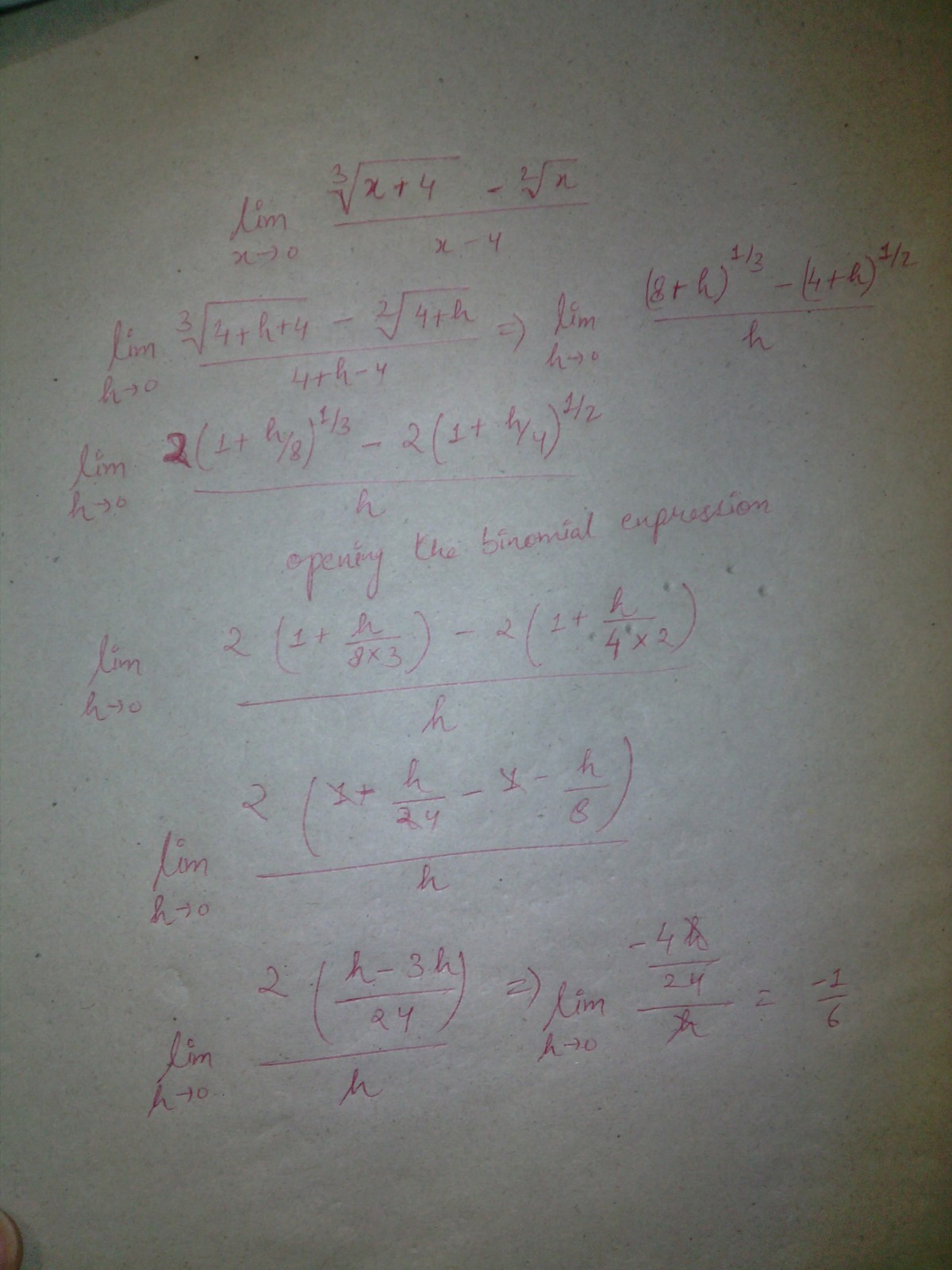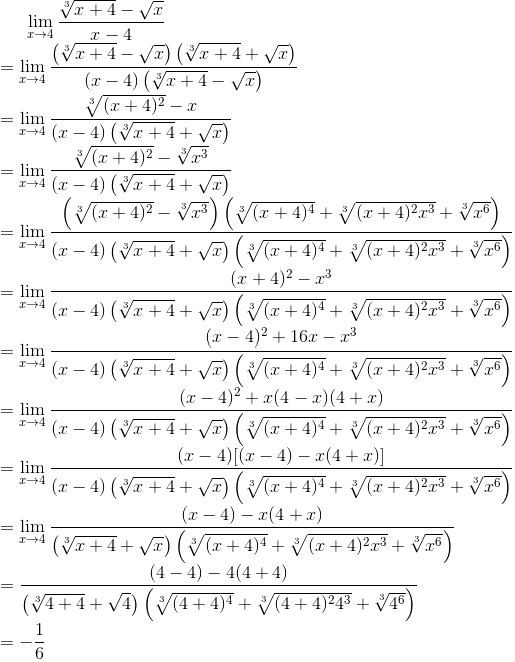Try not to use L'Hôpital!
Find the value of x → 4 lim x − 4 3 x + 4 − x .
Give your answer to 3 decimal places.
The answer is -0.166666667.
This section requires Javascript.
You are seeing this because something didn't load right. We suggest you, (a) try
refreshing the page, (b) enabling javascript if it is disabled on your browser and,
finally, (c)
loading the
non-javascript version of this page
. We're sorry about the hassle.
6 solutions
Moderator note:
Why didn't you standardize both to doing it via the definition of derivatives?
IE With f ( x ) = x , we have lim x → 4 x − 4 x − 2 = f ′ ( 4 ) .
ChallengeMaster: Oh ahah, yeah I didn't thought of that, I only saw the first one to be applicable. Plus, the second one looks like it's calling out for me to factor it.
I did it a bit differently, by taking x as x+h, where h is tending to zero. After that it was a bit easy. After that I opened the binomial expression in the numerator( neglecting the higher terms)

Nice solution! It would be better if you could write O ( h 2 ) and then cancel it with h later to form O ( h ) . @Isaac Buckley used the same method as you did, so you can refer to his method.
Log in to reply
Ya thanks. And both of the method are quite similar. I have seen his also.
We note that x → 4 lim x − 4 3 x + 4 − x = h ( x ) → 0 g ( x ) → 0 . Therefore we can use L'Hôpital's rule.
x → 4 lim x − 4 3 x + 4 − x = x → 4 lim h ′ ( x ) g ′ ( x ) = x → 4 lim 1 3 1 ( x + 4 ) − 3 2 − 2 1 x − 2 1 = 3 1 × 4 1 − 2 1 × 2 1 = 1 2 1 − 4 1 = − 6 1 = − 0 . 1 6 7
Moderator note:
And how about a non-L'hopital approach?
(For worked out solution, scroll down to the second part of this post.)
The technique is to multiply the conjugate until all the roots are gone in the numerator . However, for cube roots, (e.g. 3 a − 3 b ), instead of multiplying 3 a + 3 b , we would multiply 3 a 2 + 3 a b + 3 b 2 to get rid of the cube root.
After multiplying everything and all the roots are gone in the numerator , we would still be expecting a 0/0 form. By the factor theorem, ( x − 4 ) would be a factor of the numerator. That is why I created ( x − 4 ) 2 from ( x + 4 ) 2 . Then, long division is not needed to factorize the numerator.
If the numerator still cannot be factorized, just use long division.
(For explanation, scroll up to the first part of this post).

Moderator note:
While you have the correct general idea (and that is indeed what one should do), the act of "multiply by all of the algebraic conjugates" becomes very messy. There is a very simple way to approach this.
Hint: a − b = a 5 + a 4 b + a 3 b 2 + a 2 b 3 + a b 4 + b 5 a 6 − b 6
To Challenge Master: I have thought of using that, but I think that fraction is tooooo complicated.
Log in to reply
Let me demonstrate the "very simple way".
We have a ( x ) = 3 x + 4 , b ( x ) = x . a ( 4 ) = b ( 4 ) = 2 . Observe that a 6 − b 6 = ( x + 4 ) 2 − x 3 , and so x − 4 a 6 − b 6 = − x 2 − 3 x − 4 . We thus get:
x → 4 lim x − 4 a − b = x → 4 lim x − 4 a 6 − b 6 × a 5 + a 4 b + a 3 b 2 + a 2 b 3 + a b 4 + b 5 1 = ( − 4 2 − 3 × 4 − 4 ) × 2 5 × 6 1 = − 6 1
My steps are actually equivalent to yours, because the product of all of the conjugates does lead to the denominator a 5 + a 4 b + a 3 b 2 + a 2 b 3 + a b 4 + b 5 (I'm not sure if you knew that ). The idea is that we can avoid having to multiply them individually, or figuring out exactly what it looks like.
Log in to reply
The problem is, the readers might not instantly recognize a sixth power.
x → 4 lim x − 4 3 x + 4 − x = y → 0 lim y 3 y + 8 − y + 4 = y → 0 lim y 2 ( 1 + 8 y ) 3 1 − 2 ( 1 + 4 y ) 2 1 = y → 0 lim y 2 ( 1 + 2 4 y + o ( y 2 ) ) − 2 ( 1 + 8 y + o ( y 2 ) ) = y → 0 lim y − 6 y + o ( y 2 ) = y → 0 lim ( − 6 1 + o ( y ) ) = − 6 1
Nice solution using taylor series!
Same as that of Isaac Buckley
For the sake of variety, here's an approach that utilize the definition of derivatives.
x → 4 lim x − 4 3 x + 4 − x = = = = x → 4 lim x − 4 ( 3 x + 4 − 2 ) − ( x − 2 ) x → 4 lim ( x − 4 3 x + 4 − 2 − x − 4 x − 2 ) ( d x d ( x + 4 ) 3 1 ∣ ∣ ∣ x = 4 ) − x → 4 lim ( x − 2 ) ( x + 2 ) x − 2 ( 3 1 ( x + 4 ) − 3 2 ∣ ∣ ∣ ∣ x = 4 ) − x → 4 lim x + 2 1 = − 6 1